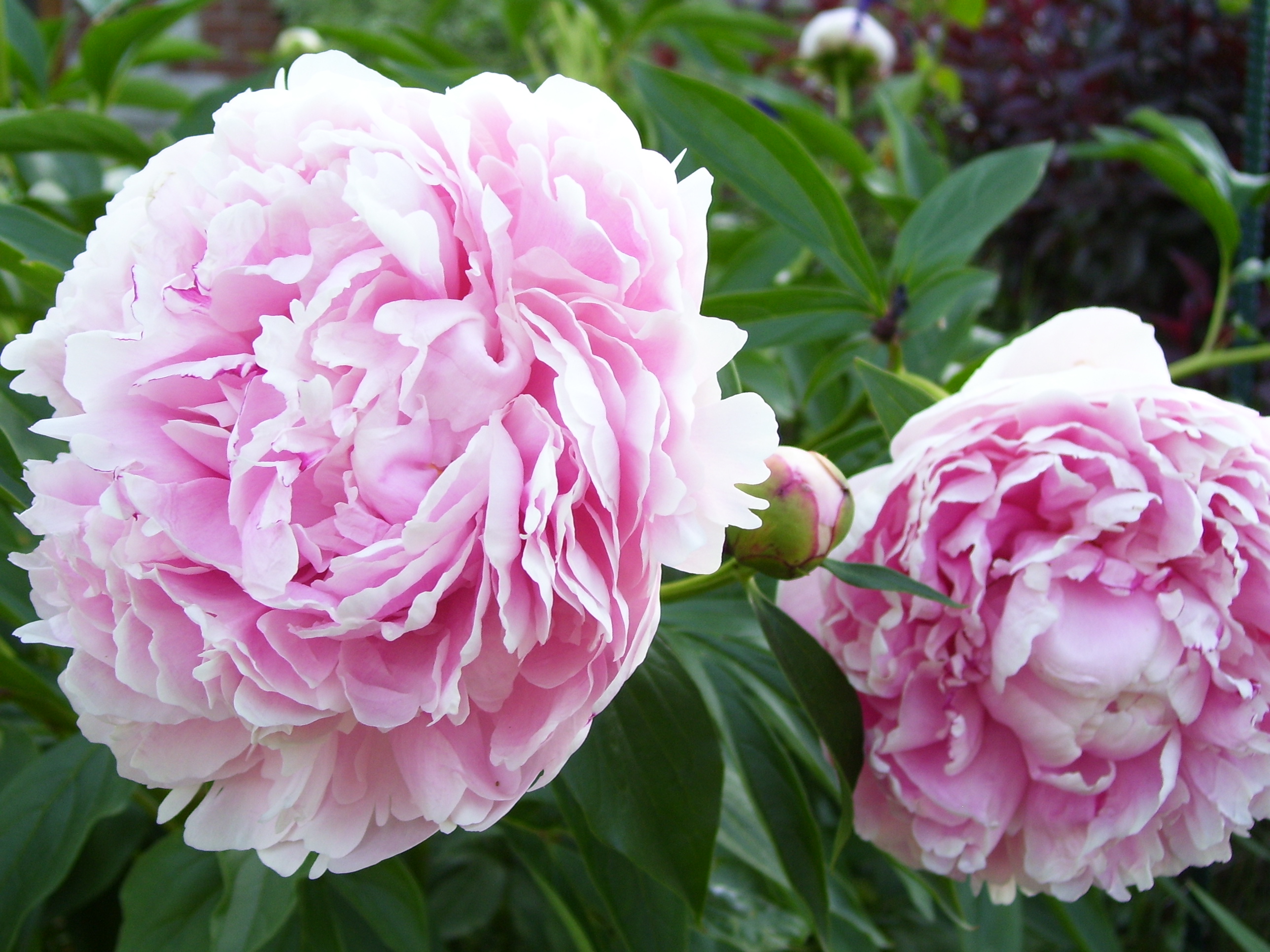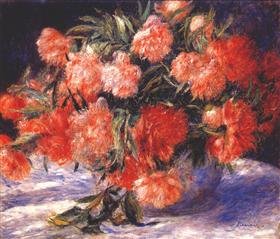Paeonia lactiflora on:
[Wikipedia]
[Google]
[Amazon]
''Paeonia lactiflora'' (Chinese peony, Chinese herbaceous peony, or common garden peony) is a
 There are several hundred selected
There are several hundred selected 
 ''Paeonia lactiflora'' became a popular still life subject for Impressionist artists in the late 19th century.
* Pierre-Auguste Renoir featured Peonies in multiple paintings from the 1870s through the 1890s.
''Paeonia lactiflora'' became a popular still life subject for Impressionist artists in the late 19th century.
* Pierre-Auguste Renoir featured Peonies in multiple paintings from the 1870s through the 1890s.
Chinese Tree and Herbaceous Peony
{{Authority control lactiflora Flora of Tibet Flora of Siberia Flora of China Flora of Japan Garden plants of Asia
species
In biology, a species is the basic unit of classification and a taxonomic rank of an organism, as well as a unit of biodiversity. A species is often defined as the largest group of organisms in which any two individuals of the appropriate s ...
of herbaceous perennial
A perennial plant or simply perennial is a plant that lives more than two years. The term ('' per-'' + '' -ennial'', "through the years") is often used to differentiate a plant from shorter-lived annuals and biennials. The term is also wid ...
flowering plant
Flowering plants are plants that bear flowers and fruits, and form the clade Angiospermae (), commonly called angiosperms. The term "angiosperm" is derived from the Greek words ('container, vessel') and ('seed'), and refers to those plants th ...
in the family
Family (from la, familia) is a group of people related either by consanguinity (by recognized birth) or affinity (by marriage or other relationship). The purpose of the family is to maintain the well-being of its members and of society. Idea ...
Paeoniaceae, native to central and eastern Asia from eastern Tibet
Tibet (; ''Böd''; ) is a region in East Asia, covering much of the Tibetan Plateau and spanning about . It is the traditional homeland of the Tibetan people. Also resident on the plateau are some other ethnic groups such as Monpa, Taman ...
across northern China to eastern Siberia
Siberia ( ; rus, Сибирь, r=Sibir', p=sʲɪˈbʲirʲ, a=Ru-Сибирь.ogg) is an extensive region, geographical region, constituting all of North Asia, from the Ural Mountains in the west to the Pacific Ocean in the east. It has been a ...
.
Description
It is tall and broad, with 9-lobed leaves long. The flower buds appear in late spring (May in the Northern Hemisphere). They are large and round, opening into fragrant, cup- or bowl-shapedflower
A flower, sometimes known as a bloom or blossom, is the reproductive structure found in flowering plants (plants of the division Angiospermae). The biological function of a flower is to facilitate reproduction, usually by providing a mechani ...
s in diameter, with 5–10 white, pink, or crimson petals and yellow stamens. The plant attracts butterflies. Its habitats include dry open stony slopes, riverbanks and sparse woodland edges.
Background
''Paeonia lactiflora'' was known as the white peony (''P. albiflora'') when first introduced intoEurope
Europe is a large peninsula conventionally considered a continent in its own right because of its great physical size and the weight of its history and traditions. Europe is also considered a subcontinent of Eurasia and it is located entirel ...
. It was brought to England
England is a country that is part of the United Kingdom. It shares land borders with Wales to its west and Scotland to its north. The Irish Sea lies northwest and the Celtic Sea to the southwest. It is separated from continental Europe b ...
in the mid-18th century, and is the parent of most modern varieties. It has been grown as an ornamental in China since the 7th century.
The Latin specific epithet ''lactiflora'' means “with milk white flowers”.
In China, ''P. lactiflora'' is likened to "the Minister of Flowers" (花相), while ''Paeonia'' × ''suffruticosa'' is known as "the King of Flowers" (花王).Cultivars
 There are several hundred selected
There are several hundred selected cultivar
A cultivar is a type of cultivated plant that people have selected for desired traits and when propagated retain those traits. Methods used to propagate cultivars include: division, root and stem cuttings, offsets, grafting, tissue culture ...
s in a range of colours, sizes and forms; many have double flowers, with the stamens modified into additional petals. There are many colors now available, from pure milk white, to pink, rose, and near red, along with single to fully double forms. They are prolific bloomers, and have become the main source of peonies for the cut flower business.
The following cultivars have gained the Royal Horticultural Society
The Royal Horticultural Society (RHS), founded in 1804 as the Horticultural Society of London, is the UK's leading gardening charity.
The RHS promotes horticulture through its five gardens at Wisley (Surrey), Hyde Hall (Essex), Harlow Carr (Nor ...
's Award of Garden Merit:
*'Bowl of Beauty' (double, pink & cream)
*'Coral Charm' (salmon pink)
*'Duchesse de Nemours' (double white)
*’Felix Crousse’ (double deep pink)
*’Festiva maxima’ (double white)
*'Laura Dessert' (double white)
*'Miss America'
*’Monsieur Jules Elie’ (double pink)
*' Sarah Bernhardt' (double pink)
*'Whitleyi Major' (single white, prominent stamens)

Chemistry
The leaves of many cultivars are high in oleanolic andursolic acid
Ursolic acid (sometimes referred to as urson, prunol, malol, or 3β-hydroxyurs-12-en-28-oic acid), is a pentacyclic triterpenoid identified in the epicuticular waxes of apples as early as 1920 and widely found in the peels of fruits, as well ...
.
Phenolic compounds
Cis-epsilon-viniferin, trans-resveratrol, trans-resveratrol-4'-O-beta-D-glucopyranoside, trans-epsilon-viniferin, gnetin H, and suffruticosol A, B and paeoniflorin esters can be found in ''P. lactiflora''. Petals color is dependent on a UDP-glucose: Flavonoid 5-O-glucosyltransferase expressing anthocyanins such as peonidin-3,5-di-O-glucoside, pelargonidin-3,5-di-O-glucoside, cyanidin-3,5-di-O-glucoside, peonidin-3-O-glucoside, cyanidin-3-O-glucoside, peonidin-3-O-glucoside-5-O-arabinoside, cyanidin-3-O-glucoside-5-O-galactoside and pelargonidin-3-O-glucoside-5-O-galactoside.In art and culture
 ''Paeonia lactiflora'' became a popular still life subject for Impressionist artists in the late 19th century.
* Pierre-Auguste Renoir featured Peonies in multiple paintings from the 1870s through the 1890s.
''Paeonia lactiflora'' became a popular still life subject for Impressionist artists in the late 19th century.
* Pierre-Auguste Renoir featured Peonies in multiple paintings from the 1870s through the 1890s. The Independent
''The Independent'' is a British online newspaper. It was established in 1986 as a national morning printed paper. Nicknamed the ''Indy'', it began as a broadsheet and changed to tabloid format in 2003. The last printed edition was publish ...
wrote of his fondness for the flower that: "They had been introduced into the horticultural world of Paris in the 1860s, so there was still something of the exotic about them, and Renoir paints them rather solemnly and majestically."
*Vincent van Gogh
Vincent Willem van Gogh (; 30 March 185329 July 1890) was a Dutch Post-Impressionist painter who posthumously became one of the most famous and influential figures in Western art history. In a decade, he created about 2,100 artworks, inc ...
painted "Vase with Peonies", "Bowl with Peonies and Roses" and "Vase with cornflowers and poppies, peonies and chrysanthemums", all in 1886.
*Claude Monet
Oscar-Claude Monet (, , ; 14 November 1840 – 5 December 1926) was a French painter and founder of impressionist painting who is seen as a key precursor to modernism, especially in his attempts to paint nature as he perceived it. Durin ...
painted "Vase of Peonies" in 1882.
*Édouard Manet
Édouard Manet (, ; ; 23 January 1832 – 30 April 1883) was a French modernist painter. He was one of the first 19th-century artists to paint modern life, as well as a pivotal figure in the transition from Realism to Impressionism.
Bo ...
cultivated peonies in his garden and painted them frequently. The Impressionist artist Frédéric Bazille painted "Young Woman with Peonies" in 1870 as a tribute to his friend Manet, knowing his fondness for the flower.
References
External links
Chinese Tree and Herbaceous Peony
{{Authority control lactiflora Flora of Tibet Flora of Siberia Flora of China Flora of Japan Garden plants of Asia